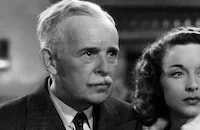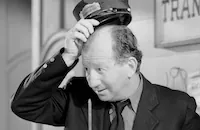The Last Ride

Brief Synopsis
Cast & Crew
D. Ross Lederman
Richard Travis
Charles Lang
Eleanor Parker
Jack La Rue
Cy Kendall
Film Details
Technical Specs

Synopsis
When socially prominent Joe Taylor discovers that his automobile tires have been stolen, he despairs of finding more because of wartime rubber shortages. Then Joe's friend, Harry Bronson, gives him the telephone number of a tire bootlegger, and a short time later, Joe receives four new tires. After the tires are installed, Joe and his girl friend, Molly Stevens, race Harry and his girl friend, Hazel Dale, to a nightclub.
During the race, Joe and Molly are killed when one of the new tires has a blow out, causing the car to swerve over a cliff. Joe's father, a newspaper publisher, insists on an investigation, and police detective Pat Harrigan is assigned to the case. Pat lives with Mrs. Kelly and her daughter Kitty, who took in Pat and his brother Mike when they were young. Kitty is in love with Mike, who has become a petty gangster. Pat's examination of the tire reveals that it consists of a thin layer of new tread attached to an old tire. After Hazel tells Pat about the events of the previous night, Pat sets a trap for the racketeers.
Two of the men are arrested on manslaughter charges, but another escapes and carries the news of the arrest to the head of the racket, police captain Charlie Butler. Meanwhile, at home, Pat finds Mike visiting Kitty. Pat suspects that his brother might be involved in the racket and advises him to get out if he can. Mike denies that he is involved, but later, in a meeting with his confederates, unsuccessfully tries to leave. After the arrested men are indicted, Pat asks for police protection for his witnesses, Harry and Hazel. After obtaining inside information, Butler telephones their location to gunman Joe Genna, who plants a bomb in their car.
In order to discover the head of the racketeers, the chief of police pretends to dismiss Pat from the force. Then later, when Pat is tipped off about a rubber robbery, he accepts a payoff to release the thieves and is invited to join the gang. Suspicious, Genna follows Pat and witnesses his meeting with the chief. Meanwhile, Pat learns that Butler is the head of the racketeers. When Genna privately reveals Pat's betrayal to Butler, Butler takes Pat to the tire plant, where he plans to kill him. After they leave, Mike learns of Butler's plans and races to the plant. There he kills Butler and is himself wounded. After telling Pat to take care of Kitty, Mike dies in his brother's arms.

Director

D. Ross Lederman
Cast

Richard Travis
Charles Lang

Eleanor Parker

Jack La Rue

Cy Kendall
Wade Boteler
Mary Gordon
Harry Lewis
Michael Ames
Virginia Patton
Ross Ford

Dolores Moran
Stuart Holmes
Creighton Hale
Jack Gardner

Howard Hickman
Leah Baird
Pat O'malley
John Maxwell
Bill Kennedy
Ed Chandler
Ed Peil Sr.

Jack Mower
Frank Mayo
Harry Strang
John Harmon
Al Hill
William Hopper
Clancy Cooper
Harry Tenbrook

Hank Mann
Eddie Foster
Norman Willis
Charles Sullivan
Crew
Milo Anderson
Leo E. Kuter
Jack Lucas
Frank Mattison
Wilbur Mcgaugh
Harold Mclernon
Francis J. Scheid
Raymond L. Schrock
Walter F. Tilford
James Van Trees
Perc Westmore

Film Details
Technical Specs

Articles
The Last Ride (1944) - The Last Ride
Between then and her A-list breakthrough, opposite John Garfield in Pride of the Marines (1945), she went before the cameras (or the microphones, in the case of voiceovers) 15 times in less than four busy years. It didn't take her long to make an impression. In 1950, she got the first of her three Oscar® nominations as a young widow toughened up fast in Caged (1950), which set the mold for women's prison movies. Her other nominations were for her performance as driven cop Kirk Douglas' wife in Detective Story (1951) and as Australian soprano Marjorie Lawrence in the biofilm Interrupted Melody (1955), detailing the diva's real-life struggle with polio. Many felt that her corrosive performance as the crippled wife of Frank Sinatra's junkie musician in The Man with the Golden Arm (1955) was far more powerful.
In all, Parker made some 60 films and segued smoothly into TV for the last decade of her performing career. She's probably most widely remembered for her performance as the Baroness in the vastly popular The Sound of Music (1965). Her biography by Douglas McClelland is called The Woman of a Thousand Faces. Its nod to Lon Chaney (and Joseph Campbell) is not, presumably, wholly unintentional. Parker's versatility and full submersion in character likely kept her from the highest ranks of stardom, where big fixed personas are a prerequisite. Let's just say that after her B-movie apprenticeship, Parker had many faces left to bring to her subsequent roles. A case in point is the crisp, workmanlike cop melodrama, The Last Ride (1944), which was practically the last film of its kind in which she appeared before going on to bigger and better things.
It would be satisfying to believe that even in this lesser but wholly professional effort Parker's star quality shone through. But the truth is she hasn't much of a role and many a young actress could have played it. She plays a boarding house keeper's daughter named Kitty Kelly. And yes, this is a film that requires you to indulge its stereotypes, circa 1944. The two grown brothers lodging there are Pat and Mike Harrigan. Pat (Richard Travis) is a cop. Mike (Charles Lang) is a crook, recycling the alignment that Jimmy Cagney and Donald Cook emblazoned across the screen in The Public Enemy (1931). (To round out the stereotyping, other cops are named Delaney, Shannon and O'Rorke; crooks are named Genna, Molino and Correlli!) The Harrigan siblings, working both sides of the moral street, are united on one thing. Both are sweet on Kitty.
Because a crook's life, at least in this film, is less demanding than a cop's, Mike has more time to schmooze Kitty. But both men rarely begin or end a meal at the Kelly table without a phone call yanking one or the other away to duty, leaving poor Kitty with little to do beyond expressing genteel dismay. To be fair, Travis energizes his scenes. Before turning to filmed crime, he performed in Western and daredevil cliffhangers, and brings to the table an ability to project urgency. It goes without saying that the brothers will find themselves on a collision course. One needn't be a seer to guess how it will end, with Kitty left to struggle bravely on with the survivor, assuming she hasn't had enough of both.
The most satisfying aspect of The Last Ride is its ability to reflect the year in which it was made. It revolves around a tire-bootlegging gang raking in plenty during the wartime years when almost all rubber went to the war effort. The gang headed by oily, treacherous Cy Kendall steals tires from cars, slaps a cheap retread on them and sells them as new. They even make house calls and accept checks. Offhand, this is the only film I recall where a murder weapon is a worn tire that explodes when a young hell-raiser floors it to 100 mph and dies with his date alongside him on a high-speed turn. Later, the killing reverts to gunplay, although in between the bad guys car-bomb a witness. The cars, by the way, pack a nostalgic punch, partly because they look like everyday cars, not sleek rentals for the latest Great Gatsby remake. It's fun to watch those pre-war Buicks, Plymouths, De Sotos and even a LaSalle on parade, even when much of the driving is against back projections!
Jay Carr

The Last Ride (1944) - The Last Ride
Quotes
Trivia
Notes
The film's working title was Murder on Wheels. The Daily Variety review notes that the film's rubber shortage plot, although timely when the film was made in 1942, was somewhat dated by its release in 1944, as the manufacture of synthetic rubber had eased the shortage to a certain extent.















